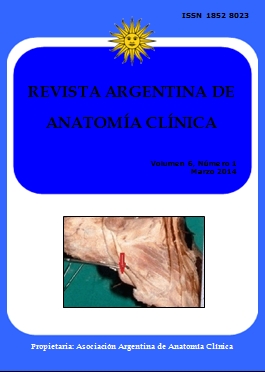ORBITAL MORPHOLOGY WITH REFERENCE TO BONY LANDMARKS. 20 La morfología de la órbita en relación a los parámetros óseos
DOI:
https://doi.org/10.31051/1852.8023.v6.n1.14094Palabras clave:
Orbital morphology, optic canal, orbital wall, Morfología orbitaria, canal óptico, pared orbitariaResumen
Las órbitas óseas son cavidades del esqueleto situadas a cada lado de la nariz. Se conocen las diferencias raciales en las medidas orbitales. El objetivo del presente estudio era determinar las distancias de varias fisuras y foramen en la órbita en relación a ciertos puntos de referencia óseos / quirúrgicos sobre los márgenes orbitales en la población india, lo que puede ser útil durante la cirugía orbital. La distancia de canal óptico (OC), fisura orbitaria superior (SOF), fisura orbital inferior (IOF) y forámenes lagrimales (LF) se mide a partir de puntos de referencia como cresta lacrimal anterior (ALC) para la pared medial, muesca/foramen supra orbital (SN) para la pared superior, sutura cigomática frontal (FZ) de la pared lateral y un punto en el margen inferior (OIM) justo encima del agujero infraorbitario. Se midió la distancia del foramen etmoidal anterior y posterior (AEF y PEF) de ALC. Se observó la presencia de foramen etmoidal media (MEF) y forámenes lagrimales (LF).La distancia media de OC fue 39,71 ±2,67 mm(deALC), 45,11 ±3,4 mm(de SN) , 48,32 ±2,8 mm(de FZ ) y 45,97 ±3,9 mm(de OIM). La distancia segura para el nervio óptico para cada pared orbital se calcula restando5 mmde la distancia más corta medida.
The bony orbits are skeletal cavities located on either side of the nose. Racial differences in orbital measurements are known. The aim of the present study was to determine the distances of various fissures and foramen in the orbit with reference to certain bony / surgical landmarks on the orbital margins in Indian population which can be useful during various surgical procedures. The distance of optic canal (OC), superior orbital fissure (SOF), inferior orbital fissure (IOF), lacrimal foramen (LF) were measured from landmarks like anterior lacrimal crest (ALC) for medial wall, supraorbital foramen/ notch (SON) for superior wall, fronto-zygomatic suture (FZ) for lateral wall and a point on inferior margin (IOM) just above the infraorbital foramen. Distance of anterior and posterior ethmoidal foramen (AEF and PEF) from ALC was measured. The incidence of middle ethmoidal foramen (MEF) and lacrimal foramen (LF) was noted. The mean distance of OC was 39.71 ±2.67 mm(from ALC), 45.11 ±3.4 mm(from SN), 45.97 ±3.9 mm(from FZ) and 48.32 ±2.8 mm(from IOM). The safe distance for optic nerve for each orbital wall was derived by subtracting5 mmfrom the shortest measured distance.
Descargas
Citas
Downie IP, Swans BT, Mitchell B. 1995. The middle ethmoidal foramena and its contents, an anatomical study. Clinical Anatomy; 8: 149.
Huanmanop T, Agthong S, Chentanez V. 2007. Surgical anatomy of fissures and foramina in the orbit of Thai adults. J Med Asso Thai 11: 2383-91.
Hwang K, Baik SH. 1999. Surgical anatomy of the orbit of Korian adults. J Craniofac Surg; 10: 129-34.
Jadhav SD, Roy PP, Ambali MP, Patil RJ, Doshi MA, Desai R. 2012. The foramen meningo-orbital in Indian dry skulls. NJIRM 3: 46-49.
Karakas P, Bozkir MG,Oguz O. 2003. Morphometric measurements from various reference points in the orbit of male Caucasians.Surg Radiol Anat, 24: 358-62.
Martins C, Costa E, Silva IE, Campero A, Yasuda A, Aguiar LR, Tatagiba M, Rhoton A Jr. 2011. Microsurgical anatomy of the orbit: The rule of seven. Anatomy Research International, Article ID 468727, doi:10.1155/2011/468727.
McMinn RMH. 1990. Orbit and Eye, Last’s Anatomy – Regional and applied. 8th Ed. UK: Churchill Livingstone, 505.
McQueen CT, DiRuggiero DC, Campbell JP, Shockley WW. 1995. Orbital osteology: a study of the surgical landmarks. Laryngoscope; 105: 783-8.
Munguti J, Mandela P, Butt F. 2012, Referencing orbital measures for surgical and cosmetic procedures. Ant J of Africa 1: 40-45.
Rontal E, Rontal M, Guilford FT. 1979. Surgical anatomy of orbit. Ann. Otol Rhinol Laryngol; 88: 382-6.
Saoemes RW, Williams PL, Bannister LH, Berry MM, Collins P, Dyson M, Dussek JE, Ferguson MWJ. 1999. Gray’s Anatomy in: Skeletal system. Churchill Livingstone, Edinburgh, London. 555-560.
Standring S. 2008. The orbit and the accessory visual apparatus, Gray’s anatomy: The Anatomical basis of Clinical practice. 40th Ed, London, UK: Churchill Livingstone, 655-66.
Descargas
Publicado
Cómo citar
Número
Sección
Licencia
Los autores/as conservarán sus derechos de autor y garantizarán a la revista el derecho de primera publicación de su obra, el cuál estará simultáneamente sujeto a la Licencia de reconocimiento de Creative Commons que permite a terceros compartir la obra siempre que se indique su autor y su primera publicación en esta revista. Su utilización estará restringida a fines no comerciales.
Una vez aceptado el manuscrito para publicación, los autores deberán firmar la cesión de los derechos de impresión a la Asociación Argentina de Anatomía Clínica, a fin de poder editar, publicar y dar la mayor difusión al texto de la contribución.



